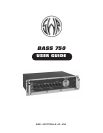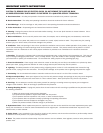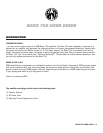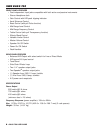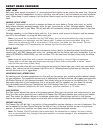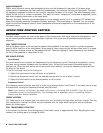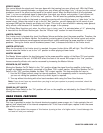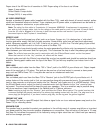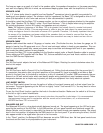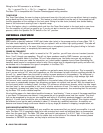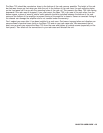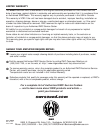
The fuse can open as a result of a fault in the speaker cable, the speakers themselves, or the power amp being
sent well into clipping. With this in mind, we recommend keeping spare fuses with the amplifier at all times.
SPEAKER JACKS
Two 1/4" phone jacks (wired in parallel) and two Speakon
®
connectors (wired in parallel) are provided for
hooking up your speaker system. The minimum load (or impedance) the Bass 750 is designed to drive is 2.67
ohms (the equivalent of one 8 ohm cab and one 4 ohm cab connected in parallel).
It should be noted that the Bass 750’s preamp section
can be run without speakers attached to the speaker
jacks. (See “Speaker Off/On Switch” under “Front Panel Features.”) This is helpful when using the amplifier
for recording purposes (via the XLR output) and speakers are not required.
Note: The frequency response of the Bass 750 is far greater than usually found in musical instrument
amplifiers (10Hz to 40kHz). This was engineered in order to give the bass player the same punch and
clarity on stage as found in the studio or concert P.A. systems. Therefore, it is doubly important that you
be aware of the impedance and power rating of the speakers that you intend to use and that they are
compatible with the Bass 750. Speakers that have been overdriven are easy to detect and are not cov-
ered under warranty.
SPEAKER CABLE
Speaker cable should be made of 18-gauge, or heavier, wire. (The thicker the wire, the lower the gauge, so 18-
gauge is heavier than 20-gauge and so on.) Do not use instrument cables to hook up your speakers. This can
result in intermittent power loss, cause your power amp to oscillate and damage itself and/or your speakers,
and render the cables useless for any purpose.
To connect the Bass 750 to your speakers via the Speakon output jacks, a Neutrik Speakon cable is required.
These cables are NOT supplied with the Bass 750, but are available from your local music retailer or directly
from the SWR Service Department.
XLR PAD
The XLR Pad control adjusts the level of the Balanced XLR Output. Rotating the control clockwise raises the
level at this output.
GROUND LIFT
The XLR Pad has a built-in Ground Lift for the Balanced out. Pulling the knob outward lifts the ground (pin 1).
If a persistent hum exists after trying both positions of the ground lift, there is probably a mis-wire or bad
ground in the feed lines to the board or console or a dirty or miswired A/C socket. SWR recommends the pur-
chase of an AC wall socket tester which can identify proper wiring (available at most hardware stores). These
inexpensive devices are a simple way to protect you and your equipment from faulty electrical systems.
LINE/DIRECT SWITCH
The Line/Direct switch gives the user the option of either a line signal (preamp out) or direct signal from the
instrument. The signal appearing at the XLR out is slightly “hotter” than normal D.I.’s. You may want to inform
the engineer of this.
To use the Line/Direct function, position the knob in the desired location. Make sure the switch is all the way
to the left or right to avoid intermittants.
Note: Turn-off transients appear at the record outs when the amplifier is shut down. It is recommended
that equipment being used in conjunction with the record out be turned down, off, or disconnected
BEFORE the Bass 750 is turned off.
BALANCED XLR OUT
The Balanced XLR out is a true electronically balanced record out. The signal appearing at the XLR out is gov-
erned by the position of the XLR Pad. In the LINE position, all front panel controls are functional except the
Master Volume, and the signal is essentially the same as that heard through your speaker system. The output
level in the Line position is adjusted by the GAIN control on the front panel. If you are using an effect, this will
also appear mixed in the signal when you are in the line mode.
In the “Direct” position, the Balanced XLR out becomes an active TUBE direct box. No front panel controls are
functional and the level is only adjustable via your instrument.
BASS 750 USER GUIDE • 7



